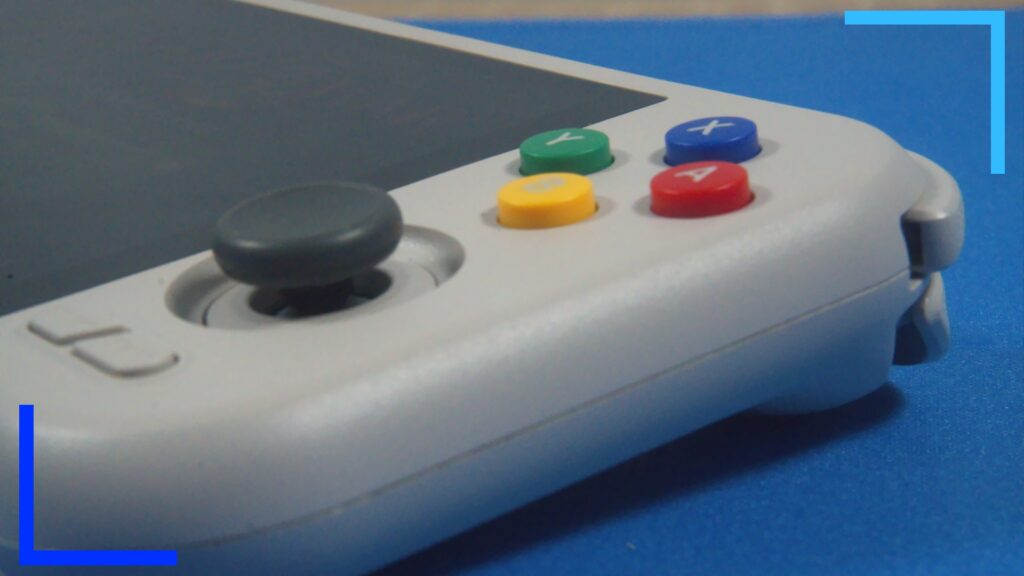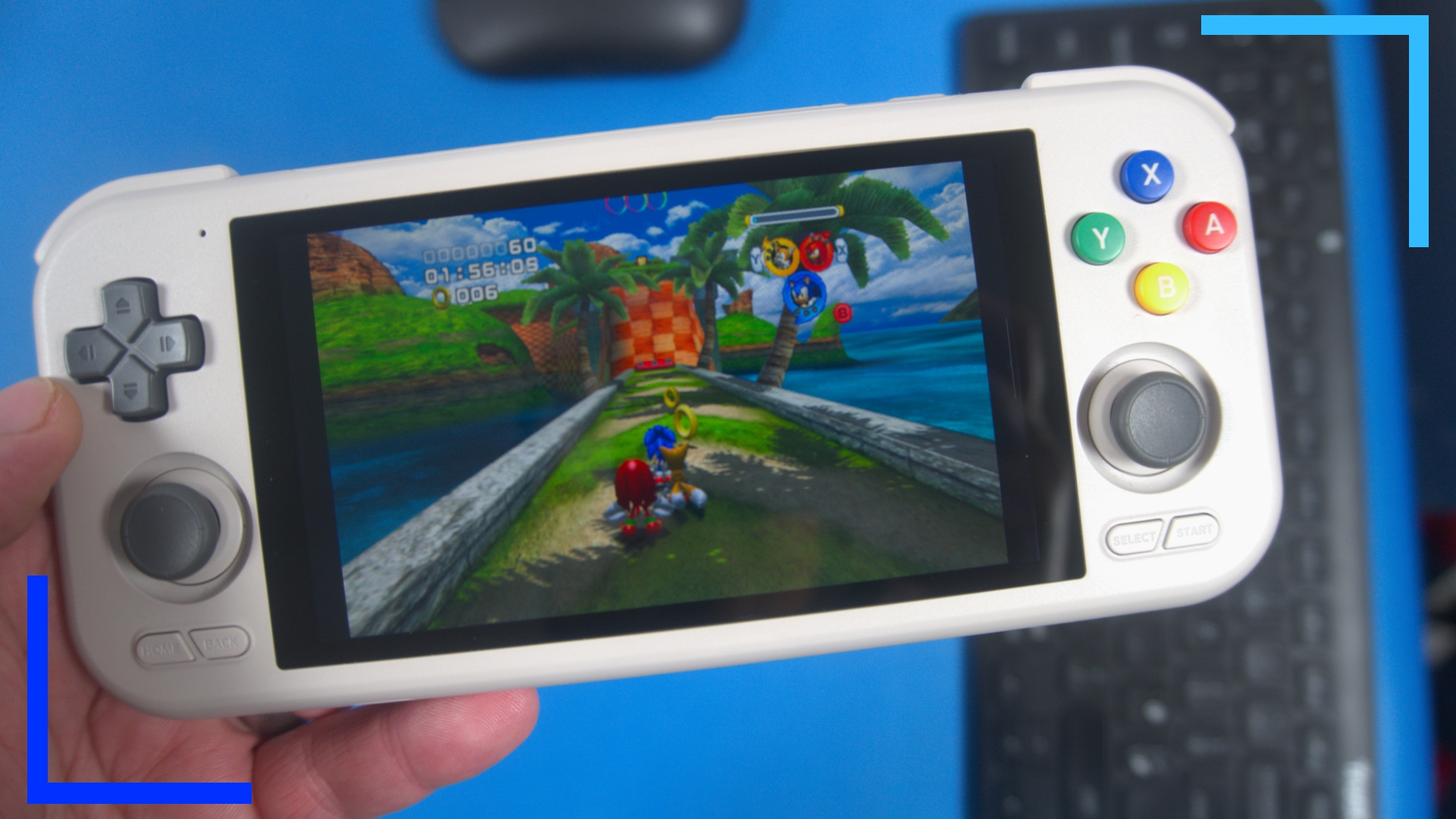The Retroid Pocket 4 Pro impresses in all the right ways. For $199, its sheer power rules in the mid-range price bracket it finds itself it. If you want near unlimited power, the AYN Odin 2 still offers up the best emulation on Android, but with prices starting at $299, that’s an extra hundred bucks you’ll need to pay for the privilege.
You will find weird kinks and a handful of areas where the Pocket 4 Pro could be improved, but if you’re after something that excels in all the right areas, this is the handheld to beat.
Design

The first thing you’ll notice when you pick up the Retroid Pocket 4 Pro is the new material. Retroid has gone with a more matte style of plastic and while it won’t be for everyone, I’m a fan of how it feels in the hand. The console doesn’t feel like it’s going to slip or slide while I’m gaming.
For the d-pad, I’d wager Retroid has one of the best ones out there. The edges have enough rock to perform minor inputs, but it’s not so prominent that it causes accidental diagonal presses. There’s also a good amount of bounce, which results in a satisfying click. Compare that with the AYANEO Pocket Air, and you’ll instantly feel the difference in feedback.
The face buttons are another area I’m a fan of. I’ve just finished reviewing the AYN Odin 2, and while I love that device, the rounded face buttons are some of the most uncomfortable I’ve ever used. With the Retroid Pocket 4 Pro, the buttons are still small, but the flat tops mean prolonged presses don’t stick into your thumb.
Moving over to the sticks, I’m convinced Retroid has gone with the same type used in the AYN Odin 2, or at least something very similar. They are slightly slimy, but I got used to that after a few hours. What matters here is that they’re concave, meaning your thumbs rest in the stick rather than on top. The end result here being sticks that offer more precision in every type of game bar racing games.
I will admit, the placement is going to cause a ruckus. When playing games like Call of Duty Mobile, I found moving around more awkward than usual and I’ve been trying to work out why. I think it’s due to needing to keep my left thumb in place lower down on the handheld. During a match, my right thumb constantly switched between the right stick and the face buttons when I needed to jump or crouch. With my left thumb, it spent more time on the left stick with less reason to move off it. If the Retroid Pocket 4 Pro went with an Xbox controller style of layout – asymmetrical stick placements – I think that would put less pressure on my left thumb. But as we’ve got a symmetrical layout, my left thumb feels awkwardly placed.
It’s not a problem for most retro games and platformers as your left thumb will be rested on the d-pad (which is where the left stick would be in an Xbox layout). I’m sure this is something I could get used to, but for first-person shooters, I’d rather play them on my Odin 2 and put up with the subpar face buttons.
At the top of the device we’ve got the triggers, and this is where things get tricky. The Pocket 4 Pro has stacked shoulder buttons, and the triggers curve outward and upward. They’re great, comfortable, and work well. That said, some users have reported problems with the internal trigger spring breaking. If you do suffer any issues, email Retroid (sales@goretroid.com) and they’ll send out all the things you need to fix it yourself. The whole process is fairly simple from what I’ve seen. And for what it’s worth, mine hasn’t suffered any problems so far. Retroid has said its also fixed the issue in new units, so here’s hoping that’s the case.
Emulation Performance

Thanks to the Dimensity 1100 chipset, the Retroid Pocket 4 Pro is currently the best sub $200 retro handheld out there. Compared with what else is available in this price bracket, it’s quite comfortably the most powerful handheld, too.
But that chipset does have a ceiling. While the Odin 2 can run Switch at a playable standard, the Pocket 4 Pro struggles when it comes to high-end emulation. Lightweight Switch games will work, but as Yuzu is designed with Snapdragon processors in mind, and you can’t sideload custom drivers, there’s currently no way I’ve found to get 3D titles running. Indie games, sure, but if you want to play Mario Odyssey or Zelda, your best option is to buy a Switch.
It’s not all bad news, though. The Pocket 4 Pro is still a strong offering in its own right. For old-school retro, even with widescreen hacks installed, the Pocket 4 Pro flies. Although that’s kind of a given nowadays, isn’t it? How does something more complex like PS2 and Dreamcast fair? That’s where the Pocket 4 Pro comes alive.
Dreamcast works near flawlessly, and PS2 works for around 90 percent of games with upscaling set to 1080p and widescreen hacks enabled. The super-complex games will struggle, but if you want to play the popular classics, they’re more than likely to work. It’s the same for GameCube. There isn’t quite enough power in the Dimensity 1100 chipset to run everything with zero issues, but a large chunk of the back catalog will work in 1080p with minimal fuss.
What’s going on under the hood? It’s all eyes on that Dimensity 1100 chipset. Compared with the Retroid Pocket 3’s Unisoc Tiger T618 chip, the Dimensity 1100 outperforms it in every way. In a quick example, the Unisoc comes with a Geekbench 6 single core score of 471. The Dimensity, meanwhile, over doubles that score at 1107. It’s the same result when you look at multicores as well. Simply put, the Dimensity 1100 is a perfect choice for something like the Retroid Pocket 4 Pro thanks to its mix of power with affordability.
Operating system

The Android 13 operating system works well, for the most part anyway. Retroid has included a game launcher for booting up select apps, and while it’s not as clean as the Odin 2’s very similar launcher, it does the job.
It’s great having everything front and center, but boy are there some weird design choices. B and A – the buttons you’d usually use to launch an app or game – bring up the app info panel. To launch something, you need to press Y – the furthest left face button. The mind boggles at such a bizarre choice. It’s not the end of the world, but when you switch between devices and your muscle memory fades, it will annoy.
Retroid also included a secondary ROM launcher, which is a bit of a pain to configure, but boasts a more Switch-like layout. When it works, it looks great, but I found myself booting into emulators rather than launching ROMs themselves a bit too frequently. It’s a nice idea in principle, but I think I’d rather wait for EmulationStation to become more reliable or go for something like Daijisho.
If you’re an Xbox controller user, it’s possible to change an option in the settings menu to change the action button from A to B, which is a pretty nice consideration. This does end up coming back to bite you, though. When I was playing Super Mario World, B then became a spin-jump rather than just a regular jump. I can change the controls in RetroArch, but I’m not sure how many people are going to want to do that for every emulator. It’s much easier to just accept B as the main action button and deal with it.
Fan Noise
The biggest problem I have with the Retroid Pocket 4 Pro is how excessively loud the fan is. Now, I play on a Steam Deck. I’m fine with some fan noise, especially when it’s a complex game running. So while I do understand why the fan needs to be loud, it’s not great when you’re trying to relax.
For old-school retro games, I found switching to Performance Mode and setting the fan to Smart or even Standard Mode with the fan off to be the quietest way to play. But for more recent emulation endeavors like GameCube and PS2, you are going to hear the fan.
In Performance Mode, with the fan set to Smart, I averaged 45 to 50 dB. With high performance turned on and the fan on Sport mode, the sound level was raised to between 55 to 60 dB. The upside is it’s not a whistling fan, but if you’re playing strenuous games, I’d advise grabbing some headphones.
Verdict

As far as upgrades go, the Retroid Pocket 4 Pro towers over the Pocket 3 with ease. The increase in power paired with a clear screen and 8GB LPDDR4x RAM means this handheld is capable of much higher emulation feats than its predecessor. It won’t rival the AYN Odin 2, but given the cheaper price, the two handhelds aren’t competing in the same space.
If you’re after a device that’s able to play up to PS2 and GameCube along with a host of Android games like Fortnite, at a price that isn’t quite in the premium category, the Retroid Pocket 4 Pro comes easy to recommend. And I’d even go as far as saying this is the mid-range retro handheld to beat.
Disclosure: Review unit purchased by RetroResolve. | To learn more about our review policy click here. | Alternatively, click here to find out why you can trust me.

